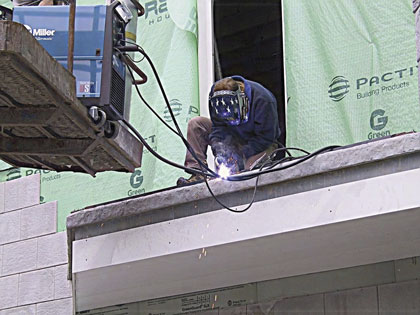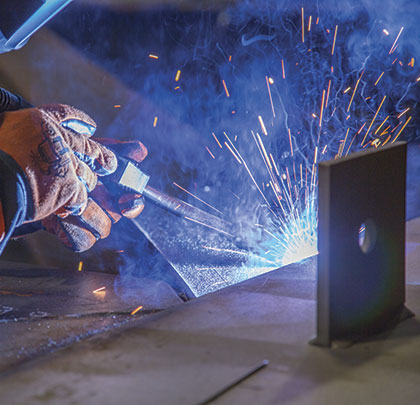Selecting equipment to provide the highest quality and productivity in a welding operation goes beyond just the power source or welding gun—consumables play an important role, as well. Contact tips, in particular, can make a significant difference between running an efficient process and accruing downtime to rectify problems. Selecting the right contact tip for the job can also impact the profitability of the welding operation. On a jobsite, these factors are critical to maintaining the arc-on time necessary to meet project deadlines and budgets.
Contact tips are responsible for transferring the welding current to the wire as it passes through the bore to create the arc. Optimally, the wire should feed through with minimal resistance, while still maintaining good electrical contact.
For that reason, it is always important to select a high-quality contact tip. While these products may cost slightly more than lesser-grade products, there is long-term value to negate that upfront purchase price; higher-quality contact tips are typically machined to tighter mechanical tolerances, creating a better thermal and electrical connection. They may also feature a smoother center bore, resulting in less friction as the wire feeds through. That means consistent wire feeding with less drag, which eliminates potential quality issues. Higher-quality contact tips can also help minimize burnbacks (the formation of a weld inside the contact tip) and help prevent an erratic arc caused inconsistent electrical conductivity. They also tend to last longer.
CONTACT TIP BASICS
Contact tips used for semi-automatic MIG or gas-shielded flux-cored welding are typically composed of copper. This material provides good thermal and electrical conductivity to allow consistent current transfer to the wire, while also being durable enough to withstand the heat generated during the welding process.
In most cases, using a contact tip that matches the designated size of the wire leads to the best results. When in doubt about selecting the proper size contact tip, consult a trusted consumable manufacturer or welding distributor.
As a best practice, always check the connection between the contact tip and the gas diffuser to be certain it is clean and secure—a clean, secure connection reduces electrical resistance that could lead to overheating.

Contact tips can make a significant difference between running an efficient welding process and accruing downtime to rectify problems; they can also impact the profitability of the welding operation.
CONTACT TIP RECESS
Contact tip recess refers to the position of the contact tip within the nozzle in a gas-shielded welding gun and is an important factor influencing weld quality, productivity, and costs in a welding operation. Specifically, correct contact tip recess can reduce the opportunity for excessive spatter or porosity. It can also help minimize radiant heat that could cause premature contact tip failure.
Contact tip recess directly impacts wire stickout, also called electrode extension. The greater the recess, the longer the stickout and the higher the voltage, which can make the arc slightly less stable. For that reason, the best wire stickout is generally the shortest one allowable for the application; it provides a more stable arc and better low-voltage penetration. Typical contact tip positions are 1/4-inch recess, 1/8-inch recess, flush, and 1/8-inch extension.
EXTENDING CONTACT TIP LIFE
Contact tip failure can result from a number of influences, including burnbacks, mechanical and electrical wear, poor welding operator technique (e.g., variations in gun angle and contact-tip-to-work-distance [CTWD]), and reflective heat from the base material, which is common in tighter access weld joints or confined areas.
The quality of the wire being used can also affect contact tip life. Poor quality wire often has an undesirable cast or helix that can cause it to feed erratically. That can prevent the wire and contact tip from connecting properly through the bore, resulting in low conductivity and high electrical resistance. These issues can lead to premature contact tip failure due to overheating, as well as poor arc quality. To extend contact tip life, consider the following:
- Keep the contact tip free of spatter.
- Use the proper drive rolls to ensure smooth wire feeding.
- Increase wire feed speeds and lengthen the CTWD to minimize burnbacks.
- Select contact tips with a smooth surface to prevent wire snagging.
- Trim the MIG gun liner to the correct length so that the wire feeds through properly.
- Lower operating temperatures, if possible, to reduce electrical wear.
- Use a shorter gun assembly, when possible, to gain smoother wire feeding. If a longer power cable is necessary, try to minimize loops and bends to reduce wire feed friction.
Contractors should also consider tracking their contact tip usage, noting excessive changeover, and addressing accordingly with some of the suggested precautions. Addressing this downtime sooner than later can go far in helping reduce unnecessary costs for inventory, while also improving quality and productivity. ■
About the Author: Greg Bauer is an engineering manager, core products, with Bernard. For more information about welding tips and other Bernard products, visit www.bernardwelds.com.
_________________________________________________________________________
Modern Contractor Solutions, September 2015
Did you enjoy this article?
Subscribe to the FREE Digital Edition of Modern Contractor Solutions magazine.



